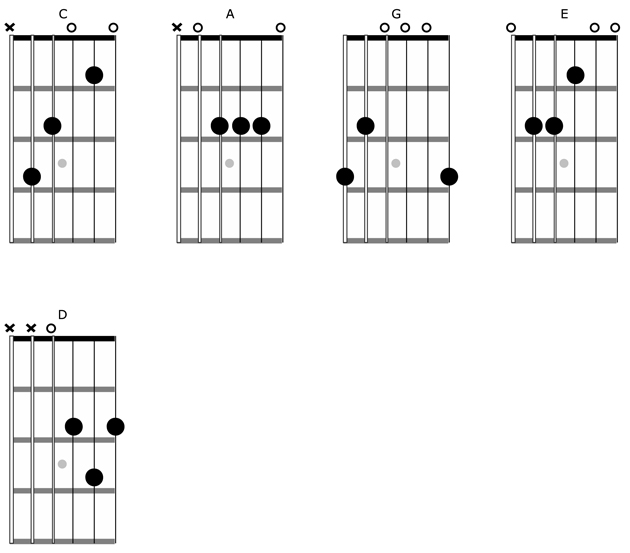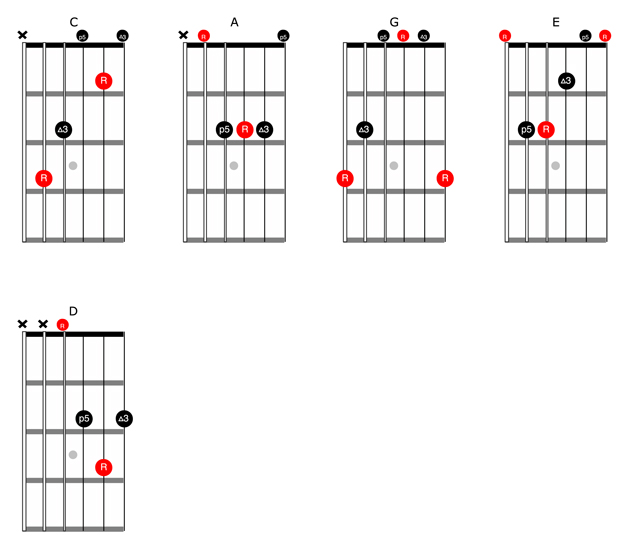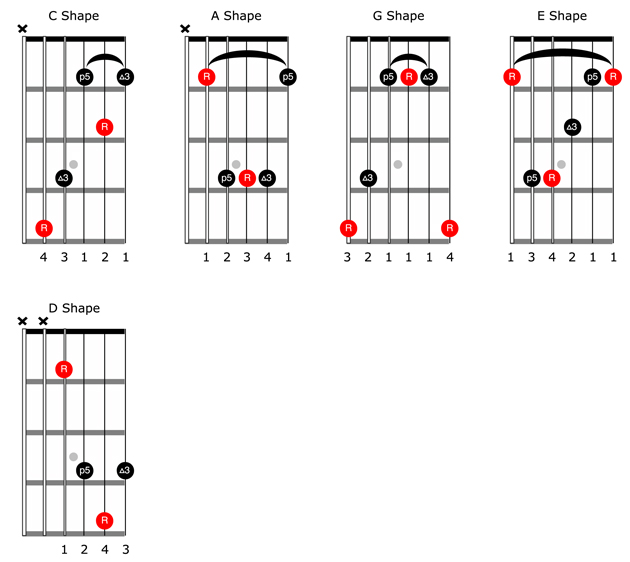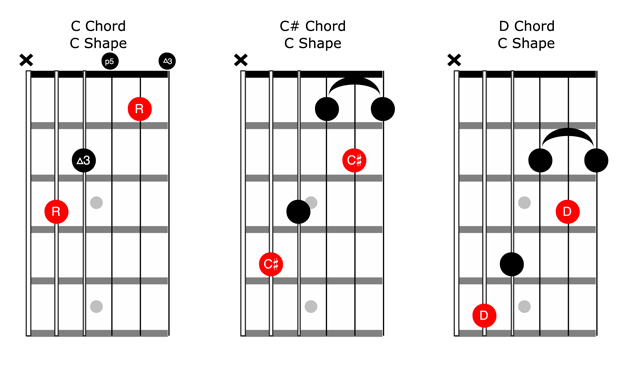
|
本帖*后由 Stone654 于 2016-12-30 15:41 编辑 CAGED:大神带你飞 Mike Cramer,翻译Stone654 丰富的指板知识是你演奏达到出神入化的前提,当你可以看出各种和弦的内在关系时,那感觉一定很美妙。这节课我们要介绍一下CAGED系统,相信你一但真正理解了它,一切问题都会迎刃而解,不过请注意只有在标准调弦下才有效。 与其赘述一大堆空泛的理论,不如找把吉他开始练习来得实际。我们会提供一个手把手的教程,你大可放心一步一步来。和一对一的课程一样,我会通过布置作业来让你了解这个系统的基本原理。废话少说,赶紧开始吧。 CAGED系统: 这个名字来自于五个基本的开放和弦:CAGED。为了搞清楚概念,你首先要知道下面五个指型。 
图1 接下来,你需要了解这五个指型中和弦的根音在哪里。根音是和弦的基础,比如说,C和弦的根音就是C。这节课我们主要关注大三和弦,它是通过叠加根音、三音、五音得到的。C调音阶是CDEFGAB,在图2中,你会看到CAGED这几个和弦中的根音、三音、五音被单独标出。 
图2 作业1: 记住每个和弦的根音位置,更进一步你可以将三音和五音的位置一并记下。 能力提高: 现在你知道了和弦的基本指型以及根音的位置,下一步就是将各开放和弦转化成封闭和弦,就是说这些和弦中没有任何空弦音。对此我们需要在原有的指型中加入横按。图3中你可以看到带有横按的CAGED这几个和弦。注意:D和弦封闭指型不需要横按。 
图3 其中有些和弦你可能很熟悉,多数初学者学习的第一个封闭和弦是A或E型,还有两种不太常见的容易按错的是G和D型。*常见的错误就是其余的手指没有和食指间隔一个空品。正确按法如图4。 
图4 你可能会觉得有几个和弦因为间距的增大而变得非常难按。为了避免肌肉拉伤的风险,请左手老老实实地采用古典手型,不要试图把拇指伸出来按弦。同时我建议你只按一些必要的音符,比如在G型中,不要六根弦全部横按;你只需要横按三个音(二三四弦)。无用功是没有必要的。 有了CAGED指型左手已经可以随意移动了,你的和弦知识也得到了极大地丰富。每一个指型都可以按出任何你需要的和弦,要做的仅仅是移动左手找到对应的根音。图5中你可以看到将C和弦下移一品变成C#和弦,继续移动则变成D和弦。 
图5 通过了解C型在五弦和六弦上的根音以及其对应的音名,我们可以推算出每个把位对应的都是什么和弦。为确保灵活应用五个指型,你需要熟知每个指型根音的位置以及每个位置都是什么音。图6列出了指板上的所有音。 
图6 作业2: 逐品移动每个指型,专注练习不要将G型和D型按错,同时要能瞬间说出指板上任何一个和弦的名字。 名称背后的秘密: 到此为止,我们都在专注于掌握所有的和弦指型,为CAGED系统利用*大化做铺垫。试着把每个指型想成品图的一块,当每一块拼在一起时,你会得到一个完整的大拼图。重申一遍,掌握此知识的*好方法就是不断地练习。练习图7中列出的每个和弦,注意把位标识以及手指间隔。 
图7 你发现了什么?如果按照正确的方式演奏,你会听出它们全部都是C和弦。希望你注意到了他们按顺序五个指型一循环,如果琴颈无限长,你会五个指型一个八度地循环。CAGED不但告诉了你构成这个系统的是哪几个指型,还暗示了它们的顺序。图8中列出了指板上C和弦的所有指型。 
图8 如果你想列出A和弦的所有指型该怎么办呢?你可以从开放的A和弦开始,沿着CAGED的顺序移动。A后面是G,所以下一个是G指型,然后是E指型,直到回到*开始的A指型。图9中的例子是按AGEDC循环的。 
图9 建立联系: 之前我说过CAGED中的每一个指型都可以看作一块拼图,当结合在一起时便会得到指板上的全部和弦。通过练习上面几个例子你应该有所察觉,和弦指型很重要的一点就是保证相邻的指型看着弹着都舒服。需要记住的是,两个相邻指型之间,至少有一个共同的音。图10中我列出了C和弦的所有相邻指型,两指型的共同音由菱形标示。 
图10 几乎所有情况下,两相邻指型的共有音要间隔一品。然而,D型和C型的共有音之间间隔两品。注意在C指型中食指的位置,通常人们会犯的错误就是按高一品。 作业3: 按顺序练习CAGED中的每个开放指型(如图8图9),一旦你开始习惯,按顺序练习全部的调。比如你可以从一个A指型的Bb和弦开始(横按1品的A指型),然后在Bb调中按照CAGED的顺序进行练习。注意相邻两指型的共有音,这可以降低和弦变换的出错率。 恭喜,通过本节课的学习你已经掌握了很多知识。 CAGED可以将你已熟悉的和弦系统化,本课为你能在指板上找到和弦提供了基础。对音阶和乐句来说它同样重要,事实上我将CAGED视为征服指板的五大工具之一:和弦、音阶、乐句以及旋律全部可以和它构成联系。这也可以帮助你整合已经学过的知识,另演奏更为高效。 原文: The Guitarist's Guide to the CAGED System Mike Cramer August 10, 2013 To get the most out of your guitar playing, you need to have a deep understanding of the fretboard. Wouldn’t it be nice if the guitar was laid out in a logical fashion? Well, it is, and in this lesson I’m going to introduce the CAGED system. I believe that once you understand the CAGED system, you’ll be able to “crack the code” and see the fretboard’s inherent logic. Note: This system only works with standard tuning. Instead of giving a lengthy description of the CAGED system, I’ve found the best way to learn it is to immediately get your hands on the material. Think of this lesson as a hands-on tutorial. Step-by-step, I’ll walk you through the basics of this system while providing practical assignments—as if we were in a one-on-one lesson. Grab your guitar and let’s get to it! The CAGED System The CAGED system derives its name from five basic open chord shapes: C, A, G, E, and D. To get the most out of this lesson you must know these five chord shapes (Fig. 1). Next, you need to know where the root of the chord is located in each of the five shapes. The root is the foundation of the chord. The root of a C chord, for example, is C. Major chords, which we’ll focus on in this lesson, are built by stacking the root, 3rd, and 5th notes of their respective major scales. The notes of the C major scale are C–D–E–F–G–A–B. Therefore the root, 3rd, and 5th notes of a C chord are: C–E–G. In Fig. 2, you’ll find the five CAGED chords with the location of the root, 3, and 5 labeled in each chord diagram. Assignment #1 Memorize the location of the root in each chord shape. For extra credit, memorize the location of the 3 and 5! Moving On Up Now you know the basic shapes and the location of the root for each shape. The next step is to convert each open-position shape to a closed-position shape—meaning there won’t be any open strings involved in playing the chord shape. To do this we must create barre chords out of each of the CAGED shapes. In Fig. 3 you see all of the CAGED chords as barre chords. Note: No barre is needed to play the D shape as a closed chord. Some of these shapes may feel like old friends. The first barre chords most guitar players learn are the barre form of the A and E shape. Two shapes that are less familiar and prone to spacing errors are the G and D shapes. The common spacing error is to compress the fingering of the shapes. Be sure to keep an empty fret between your first finger and the remaining fingers used to build the chord, as shown in Fig. 4. You may find a few of these shapes are difficult to grab due to the stretching involved. To minimize strain, don’t wrap your thumb up and over the neck on the 6th string side, keep it behind the neck. Also, I encourage you to only barre the necessary notes. For example, when playing the G shape, don’t barre across all six strings; you only need to barre three notes (the 2nd, 3rd, and 4th strings). Why create any extra work? By converting each of the five CAGED shapes into barre or movable forms, you have exponentially increased your chord vocabulary. Each individual shape can become any major chord you need: Simply move the chord up or down the neck and place the shape’s root on whatever note you want—it’s that easy. Take a look at Fig. 5 and you’ll see that moving the C shape up one fret creates a C# chord, and moving it up one more fret creates a D chord. By knowing that the root is located on the 5th and 2nd strings in the C shape and knowing the names of the notes on those two strings, I was able to correctly identify the actual chord I produced by shifting the C shape to these other locations. To do this with all five shapes, you need to know the location of the root within each shape and the names of the notes on the fretboard. Fig. 6 names all the notes on the fretboard. Assignment #2 Move each shape up and down in half-steps (one fret at a time), focusing on keeping the shape together and not collapsing the G and D shapes. Also, be able to identify the correct name of the chord at any place along the neck. What’s in a name? Up to this point, we’ve focused on acquiring the chord shapes and laying the foundation for realizing the full potential of the CAGED system. Think of each shape in the system as a puzzle piece: When all the pieces are connected, you will have mapped the entire fretboard. Again, the best way to see how this works is to play through it. Play each of the chords listed in Fig. 7, paying attention to the fret markers and spacing of the shapes. What did you notice? If you played the chords correctly, you should have heard that they were all the same chord—all C chords. Hopefully you realized that all five shapes were used and that you ended with the same shape you started with (assuming you have a cutaway on your guitar that allows you to access the higher frets). By the way, did you notice the order of the shapes used in this example? The name CAGED not only tells you what chord shapes make up the system but also the order that the shapes connect to one another to map out the fretboard. Fig. 8 places all five shapes as C chords in one fretboard diagram. What if you want to map out the chords in the key of A the same way you did for C? To do this, start with the open position A chord—an A chord with an A shape. Then think of the spelling of CAGED and find the letter following A, which is G. So, play an A chord with a G shape. Then it’s an A chord with the E shape, and so on until we return to the A shape. So in this example, our CAGED shape sequence is AGEDC. This sequence is mapped out in Fig. 9. Making Connections Earlier I said to think of the CAGED shapes as individual puzzle pieces that, when connected, map out the entire fretboard. By playing through the above examples, you’ve experienced this. When mapping out a chord, it is important to be visually and physically comfortable with how two adjacent shapes connect to each other. A general rule to keep in mind: Between two adjacent shapes, there will always be at least one note that’s common to both shapes. In Fig. 10, I’ve diagrammed all pairs of adjacent shapes for the C chord. Common notes between two shapes are indicated with a diamond. In almost all cases, the common note(s) between shapes span a one-fret region. However, the common notes between the D and C shapes span a two-fret region. Pay attention to the placement of your first finger when setting up the barre for the C shape. The common error is to place the first finger a fret higher than it’s supposed to be. Assignment #3 Play through the CAGED sequence starting on each of the CAGED chords in open position (like we did in Fig. 8 and Fig. 9). Once you’re comfortable with this, play the sequence in all keys. For example, start with a Bb chord using the A shape (an A shape barred at the 1st fret), then play the CAGED sequence in the key of Bb. Pay attention to the common note(s) between two adjacent shapes—this will help minimize errors in shifting and connecting shapes. Congratulations, you’ve made it to the end of the lesson and covered a lot of territory! The CAGED system provides a logical way of visualizing the neck using basic chord shapes you’ve most likely known for quite some time. In this lesson, we’ve laid the foundation for being able to find chords all over the neck. It doesn’t stop there though. The CAGED system is just as useful for scales and licks. In fact, I think of the CAGED system as five containers where I can put fretboard information. New chords, scales, licks, and melodies can all be related to one of the five shapes, and this allows you to integrate this information into your playing quickly and efficiently. 附: Chops: Beginner Theory: Beginner Lesson Overview: • Learn how to convert all open-position chords to moveable shapes. • Identify the location of the root in each shape. • Discover how to connect all five CAGED shapes to map out the entire neck in any key, starting on any one of the five shapes. 原文链接:http://www.premierguitar.com/art ... caged-system?page=1 |






 希望能多出点这样的乐理贴
希望能多出点这样的乐理贴 这个好
这个好